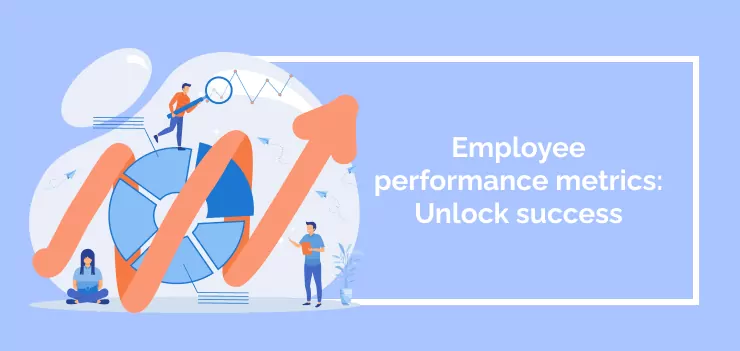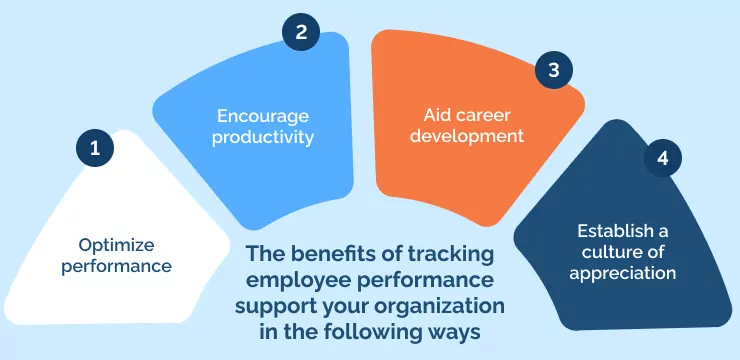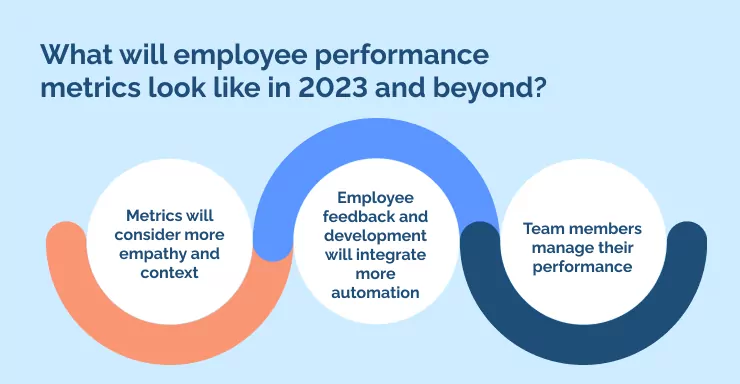
Most of us are familiar with the phrase ‘a chain is as strong as its weakest link’.
Despite this being true, it’s important how we deal with this scenario that leads to motivation or frustration for staff.
This process forms the core of organizational success or failure, based on the supported performance of each individual, as an organization begins to measure employee performance.
For example, Wellable research shows that 69% of employees would increase their productivity if they felt more appreciated by their employer.
However, despite their limitations, employee performance metrics help enterprises understand why individual staff members struggle to perform as expected.
But, it is also important to understand the reasons behind the numbers as you measure employee effectiveness with metrics.
The staff can then receive support to meet their needs and help them achieve, reducing frustration and increasing productivity for the success of any small or large project.
Let’s explore employee performance metrics to help you unlock success via the following topics:
- Why use employee performance metrics to assess your staff?
- What are the benefits of employee performance metrics to your organization?
- What are the top 5 employee performance metrics to track?
- What are the limitations of using employee performance metrics?
- What will employee performance metrics look like in 2023 and beyond?
Why use employee performance metrics to assess your staff?
Measuring results benefits employers and employees as it enables them to track the company’s progress.
WEBMASTER: Please embed the below link.
Understanding performance metrics
Although tracking employee performance may seem strict, it helps to understand the team’s progress and provides an opportunity to acknowledge employees’ hard work.
How you communicate that employee performance metrics are there to support, not penalize staff, is essential to the success of implementation.

The benefits of tracking employee performance support your organization in the following ways:
- Optimize performance: analyze employees’ KPI data to identify team skills gaps and take necessary measures to address lower output.
- Encourage productivity: consider sharing the current month’s employee productivity numbers compared to previous months. Similarly, to emphasize the importance of good customer service, share results of customer satisfaction surveys. Employees will prioritize those aspects of their work by demonstrating the management’s priorities.
- Aid career development: use KPI reports to establish expectations. They enable team members to evaluate their current performance against their desired performance, thereby assisting them in establishing precise career objectives.
- Establish a culture of appreciation: leaders keep track of employee progress to recognize their accomplishments. It’s essential to identify the relevant metrics that support improvement goals and use them to acknowledge and reward hard-working employees.
Awareness of why you must use metrics can help your staff is essential to help your organization come out on top against competitors.
Metrics vs. KPIs
Metrics like those to use employee performance and KPIs (key performance indicators) are often confused. Let’s explore the differences to help you understand how to use each to support a successful organizational culture change that sticks.
Metrics
Measures progress of processes
Low-level perspective
Relevant for one department
Operational/ tactical
KPIs
Measures progress of goals
High-level perspective
Relevant for several departments
Strategic
The main difference between metrics and KPIs is that metrics look at a smaller group of processes and staff in a single department. In contrast, KPIs measure the progress of goals across a more significant proportion of the organization from a strategic perspective.
What are the 5 key employee performance metrics to track?

Measuring employee performance falls into five top performance metrics to track your staff’s progress, beginning with the quantity of work they produce.
1. Quantity
These are the easiest to measure and likely the first to come to mind when considering employee metrics. These apply to outcomes that you can directly measure numerically.
For instance, “How many units do we produce per hour” or “How many sales calls do we complete weekly.”
The numbers indicate work getting done, which is essential to track. But they don’t tell the whole story, as you can’t rely solely on this metric to indicate success. Be open to learning more through additional KPIs like those on the rest of this list.
2. Quality
A team member’s work quality affects customer success and team productivity. Substandard work can hurt your image and lead to rework, harming team morale. Staying on top of any issues helps you avoid these problems.
Quality may seem abstract and one of the more unconventional employee performance metrics. Still, you can take measurements indicating how good employee work is. For instance, “the number of bugs in a software product” or “the number of faulty units.”
For jobs with less concrete products, say, customer relations, you can measure their impact, like percentages of customer engagement, using quality metrics.
3. Effectiveness
An employee’s effectiveness is often evidence of their problem-solving or innovation skills. Someone who completes their work correctly and on time shows they know how to tackle problems or optimize processes.
Effectiveness measures can include things like “whether employees consistently meet deadlines,” “how much overtime they take,” “how often they reach their employee performance goals,” or “if they correctly prioritize tasks.”
These numbers can help leaders know how to help employees progress. For instance, an employee racking up lots of overtime may need help prioritizing their work. Or, those who are consistently on time may have strategies for streamlining work that could benefit the whole company.
4. Teamwork
Working well in a team is a vital skill in many industries. Companies increase success rates when individual employees are willing and able to brainstorm, solve problems collectively, and reach out to other teams to lend a hand.
Again, these measurements aren’t as straightforward as quantity. But you can gather feedback on a scale by running pulse surveys asking employees how they or others step up to help their team to improve employee efficiency within a group.
You can also have leaders track how often employees volunteer to help with things not formally assigned to them.
Teamwork metrics help you see where your strongest team players are and give you a sense of which employees could use coaching to improve the overall team dynamic, improving team cohesion, and employee retention.
5. Learning and development
Employee development is crucial to keeping your company competitive in an ever-evolving workplace. Track your training programs’ success to ensure you’re keeping up.
Completion rates and quiz scores can partly measure training success. But you can also gauge the skills and knowledge from training on the job.
If you’re unsure where to start with training, check out these employee training templates to get you started.
What are the limitations of using employee performance metrics?

Despite their advantages and central place in every successful project, all employee performance metrics have many limitations, mainly related to reducing individuals in your company to numbers and failing to see the person behind the role.
However, being mindful of these limitations can help any leader work with staff to help them align their goals with those of their organization.
Accuracy requires large periods
Sometimes, metrics may not provide immediate actionable insights. The results of implementing a new initiative, program, or sales process may not be visible immediately. It takes time to evaluate the effectiveness of these efforts and techniques.
Additionally, some metrics may require time to reflect the actual outcomes accurately. Therefore, it is crucial not to act too quickly based on good or bad data.
Data overload
It can be overwhelming to track excessive information, leading companies to struggle with identifying the relevant data. Sometimes, metrics can yield conflicting information or require extensive analysis to ensure accurate results.
It is best to use metrics selectively to monitor the most critical organizational goals rather than watching everything.
The need for standardization
Metrics can evaluate the internal progress of a company toward its goals, such as team performance. However, these metrics may not indicate how the company performs compared to external competitors.
Since companies have their reasons for measuring various aspects, metrics are not standardized to facilitate comparisons with companies in the same industry.
Leaders often overlook small wins
Metrics are often limited to a yes-or-no evaluation, where organizations only focus on whether they achieved their goal. This approach can be a drawback as companies may overlook important milestones accomplished while progressing towards their goal.
Metrics only measure a company’s success or failure against a particular metric, which may not necessarily indicate whether the company is moving in the right direction.
Over-reliance on action steps
Although tracking performance through metrics is essential, it can only be valuable if people act on the data they receive. One drawback of metrics is that they require follow-up.
Decisions regarding whether procedures need to be adjusted, if the company is measuring the right metrics, or if a process is working correctly depend on evaluating and analyzing the metrics. Without this, metrics are not effective.
Lack of focus on relationships
Although a company may achieve its goals using metrics, it may still struggle to cultivate positive relationships with people. Building and maintaining strong relationships, both internally and externally, is crucial to the success of any business.
Metrics cannot measure the loyalty and strength of these relationships, or the company’s culture, which are essential to the organization’s overall health.
Although employee performance metrics have notable advantages, it is essential not to overlook their disadvantages. The effective use of KPIs can enhance an organization’s bottom line, but it is equally crucial to acknowledge their limitations.
What will employee performance metrics look like in 2023 and beyond?

Due to change being the only constant in any marketplace, it is essential to look to the future and consider how employee performance metrics must change with shifting needs in 2023 and beyond.
Metrics will consider more empathy and context
Performance reviews will start acknowledging the impact of context on outcomes.
For instance, are any of these scenarios valid for your organization:
- Did a high-performing employee take on a new project role to acquire new skills?
- Did a team member encounter difficulty concentrating due to a personal tragedy?
- Are teams facing issues in achieving their goals because of repeated problems with collaboration technology?
It is crucial to create performance ratings that are more empathetic to attract and retain high-performing employees who want to advance their careers within an organization.
Doing so could involve categories like “learning new skills” to recognize employees who excel in challenging projects or “focusing outside of work” to ensure that employees facing challenging personal circumstances are not unfairly penalized as their organization continues to track employee performance metrics.
Employee feedback and development will integrate more automation
Employees understand the input and developmental support required to enhance their performance even more than their managers. However, they may not have enough opportunities to participate in the process actively.
Organizations invest more in technology monitoring employee productivity in today’s hybrid work environment. By collecting and analyzing data on employee activities, these tools can help individuals track their performance and identify areas for improvement.
Eventually, this technology will automate feedback processes and promptly deliver data-driven feedback to employees.
Team members manage their performance
As technology usage increases and employees take more control of their performance, managers will shift their focus from performance management talks to guiding employee career growth and development.
HR leaders must provide managers with the tools to support talent development, handle challenging work scenarios, and aid employees in selecting their following projects and skills.
Remember that employees are not made to measure
Tracking employee performance metrics can be a powerful tool to assess staff performance and ensure organizational success.
By understanding the impact of employee performance metrics now and in the future, organizations can make informed decisions on which performance metrics suit them and which areas need improvement.
However, organizations must be aware of the limitations that can come with employee performance metrics. While they offer numerous opportunities to improve processes and operations, they may not provide all the answers.
With this knowledge, organizations will be in a much better position to set realistic expectations from employee performance metrics – now and in 2023 as they achieve business success.
Tristan Ovington
Tristan Ovington is a professional senior writer and journalist, specializing in providing expert insights on various topics such as digital adoption, digital transformation, change management, and Cloud apps. He delivers his knowledge through accessible online content that is data-driven and presented in a friendly tone, making it easy for readers to understand and implement.



